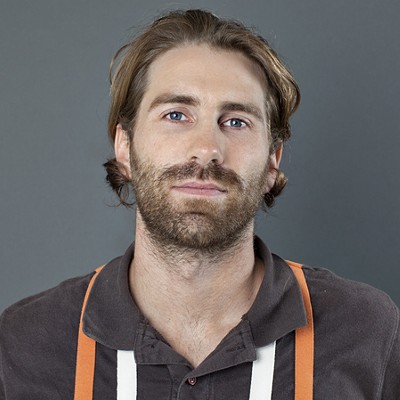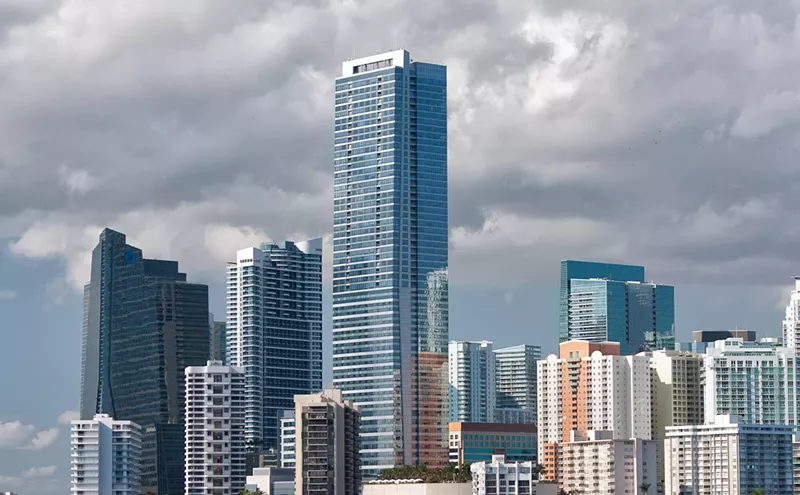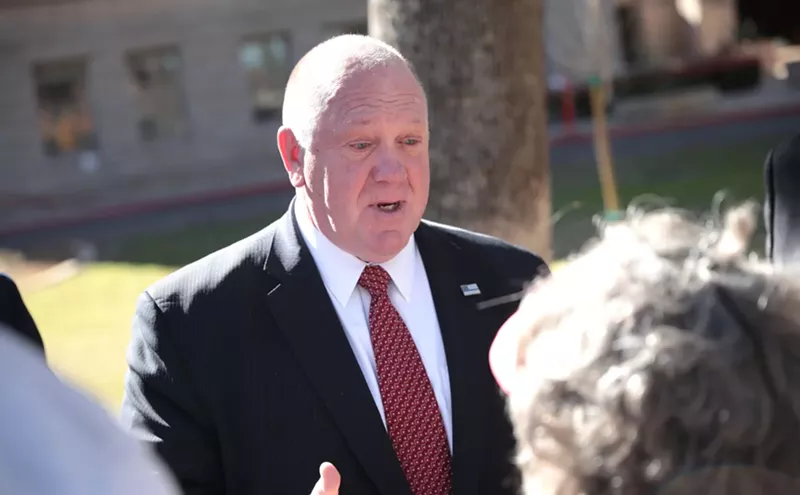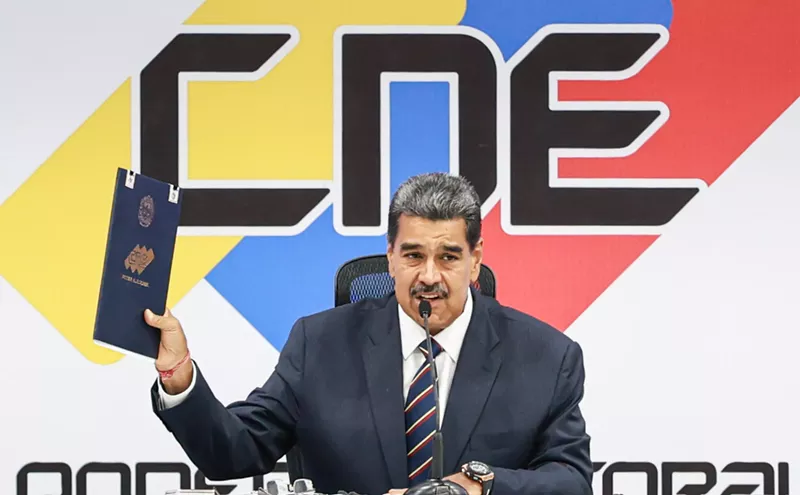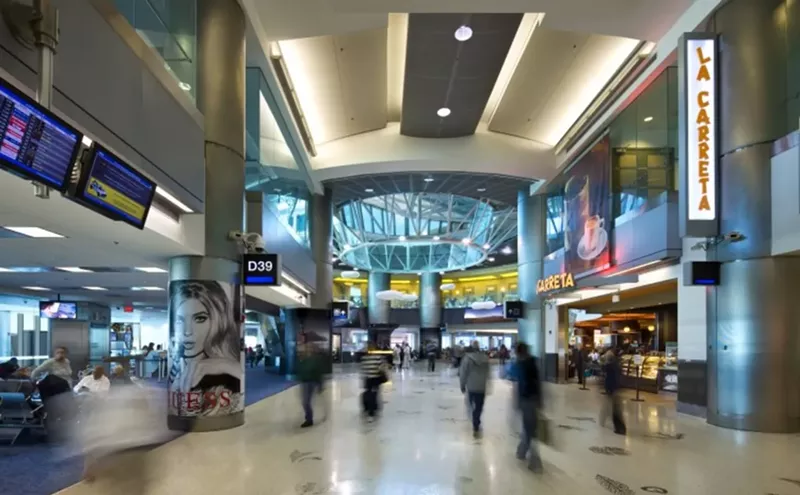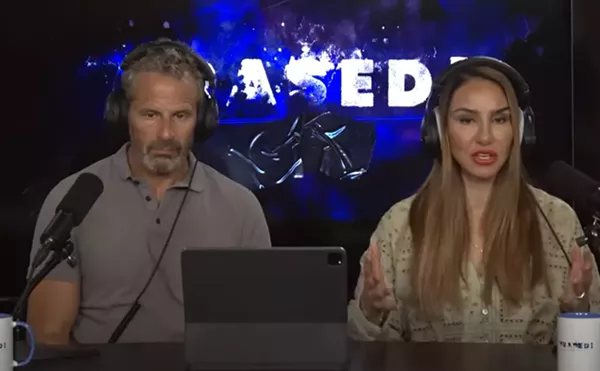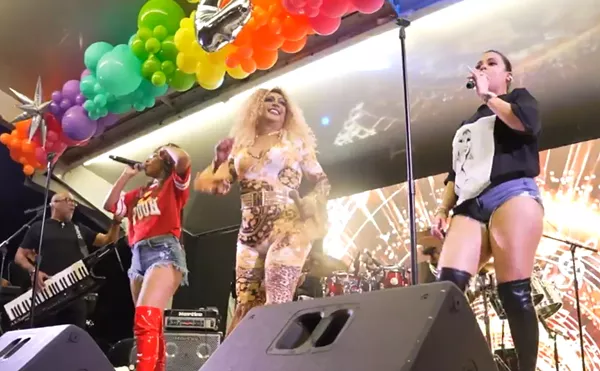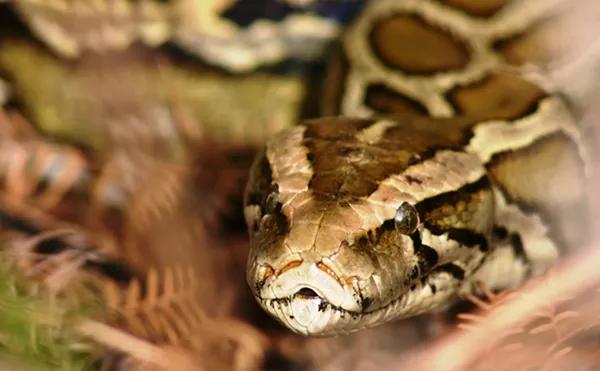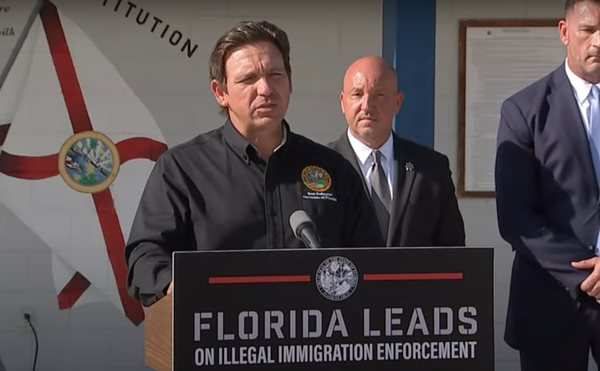When the shots rang out, they came in flurries. The pops drowned out the music echoing through the Spot, a Caribbean restaurant in Liberty City that by midnight had transformed into a nightclub where dozens of local young people, some in middle school, flirted and rubbed sweaty bodies in the dark.
Among the partiers was Will Campbell, a handsome, athletic 17-year-old with close-cropped hair and soft brown eyes. Campbell had grown up in Liberty Square, the nearby housing project notorious for rough conditions and violence. Now he was a well-liked student-athlete at Miami Jackson Senior High.
When the gunfire exploded, it was hard to tell how many bullets ripped through the restaurant. Maybe 50. Maybe 100. The Spot erupted into chaos. Screams. Cries out for friends. Confusion. Clubgoers poured out through the iron-barred front door, spilling out onto NW Seventh Avenue.
Some ran for cover behind a nearby Miami Dade College building. Others stayed low to the ground, instinctively following the practice they'd known since childhood. Some sprinted toward a pool hall across the street, where the stocky owner was hosting a birthday party for his son. As terrified teenagers ran into the night, the owner locked the door. Campbell and a friend jumped into a car and sped from the scene before police and paramedics arrived.
"Can anyone tell me what in the world were teens as young as 11 doing in a club?"
tweet this
Inside the club, the cops found a 16-year-old splayed on the ground, his torso ripped with lead. Paramedics loaded bleeding young men and women onto stretchers bound for Jackson Memorial, where other victims had already caught rides with friends.
By the next morning, pools of blood stained the sidewalk. One bullet was found in a mailbox two blocks away. Yellow police tape cordoned off the Spot's black exterior, feet from the hand-painted block lettering that innocently advertised "Happy-Hr 5-7 pm," and "Wi-Fi." Authorities soon announced the final tally: 15 wounded, aged 11 to 25, with one teen in critical condition.
The September 27, 2014 violence was the largest mass shooting in Miami in decades. But cops had few answers for the global media covering the story. "We are still baffled as to why so many young people were shot," Sgt. Freddy Cruz, a Miami Police Department spokesman, told reporters the next morning, "and what they were doing there."
More than eight months later, many of those questions remain. The Spot lies abandoned, pending a county order for demolition. Two teenagers — including Will Campbell — face a possible life behind bars for more than a dozen counts of attempted murder. And a community is still reeling from the violence.
In Liberty City, shootings among young people are almost incomprehensibly frequent. But the shooting that Saturday night was a tipping point.
"That rung out in Liberty City," says Agnes Strange, a lifelong resident who works as a secretary at Mount Calvary Baptist Church, just a few blocks from the Spot. "The crowd that was there — they should have been escorted to the skating rink... That's what really knocked a lot of people off their feet. Because so many babies — their lives were at stake!"
The untold story of Campbell offers new insight into the violence that's tearing apart the fabric of one of the South's oldest and once-proudest black neighborhoods.
"They all grow up good kids," says Eric Thompson, an activist at the Liberty Square housing project. "It's just something went wrong."
For blacks in Florida in the 1940s, there was no better place to live than Liberty City. When Miami was founded at the turn of the 20th Century, the burgeoning city already had a large African-American population: Lemon City, present-day Little Haiti, had existed as a black community since soon after the Civil War, and Overtown, or "Colored Town," was soon established to create a separate neighborhood for African-Americans, nearly all of whom worked for whites.
When the city's white population expanded north, blacks in Lemon City were forced west. Their new settlement, inhabited mainly by farmers, was christened Liberty City; then, in the early 1930s, the neighborhood dramatically ascended.
Soon after Franklin Roosevelt was elected president in late 1932, according to historian Marvin Dunn, the president-elect visited Miami for a short vacation. He stopped to see Jon Culmer, the African-American civil rights leader, at his home in Overtown and was horrified by the squalid conditions. "He said he was going to do something about the situation," Dunn says.
The result was Liberty Square, a new federally funded program founded in 1937. The community was segregated from white Miami, with a wall constructed along present-day 12th Avenue. Residents weren't allowed to leave without permission, and some never left at all — planting the seeds of the racial and cultural divide that persists to this day. Eventually, everyone began calling it by its enduring nickname: Pork 'n' Beans, possibly in reference to the canned food eaten by many residents.
Within a few years, Liberty Square and surrounding Liberty City were thriving. Residents scrounged savings to open small businesses and build churches. As one of the few black communities in the country with indoor plumbing and electricity, the "new city," or "Model City," emerged as a middle-class destination, attracting teachers, lawyers, and businesspeople. "You were living like in Beverly Hills," says Freeman Wyche, the 80-year-old pastor of Liberty City Church of Christ.
The neighborhood became a stopover for black celebrities through the 1950s and early '60s. When Aretha Franklin traveled to Miami, she stayed at the Hampton House, off NW 27th Avenue; when Muhammad Ali came to town following his gold medal win at the 1960 Summer Olympics in Rome, Malcolm X took his picture at the hotel.
But by the late '60s, the community was ripping at the seams. The construction of I-95 had displaced thousands of residents from Overtown. "Where did they go?" Dunn says. "They went to Liberty City." And with no other housing options, he says, the impoverished Overtown refugees had no choice but to move into private, white-owned "concrete monsters" — the massive apartment buildings that Dunn says were horribly maintained by indifferent owners.
Around 1967, when Horace Roberts was a student at all-black Miami Northwestern High, the best teachers were suddenly sent to white schools, he says. They were replaced by white educators who didn't understand the culture of Liberty City and its kids. "They came in with preconceived ideas about this community," says Roberts, now the interim director of the Belafonte Tacolcy Center. "They come to teach and they go home."
"There was a certain unrealistic expectation blacks had about integration," Dunn adds. "We thought that integration was a good thing... but there were unintended consequences."
The next couple of decades only got worse — police tension, the crack epidemic, grinding poverty. The first riot came in 1968, after a chain of events that began when Wilt Chamberlain failed to keep his promise to show up in Liberty City, Dunn says. The biggest riot broke out in 1980, when four white police officers were acquitted of murdering Arthur McDuffie, a local black insurance salesman.
Housing conditions at Liberty Square and another nearby project, nicknamed the Graveyard, became increasingly desperate. Economic opportunity dried to a trickle. "A good-paying job is at McDonald's or Burger King," Thompson says.
Yet even through the 1980s, some residents say, Liberty City was losing its economy but maintained its family-oriented identity. There was gun violence and disputes, but mass shootings were rare.
"It had its dirt," says Strange, the Calvary Baptist secretary. "But not the killing dirt. You understand?"
Twelve-year-old Will Campbell had to use wooden posts as a step ladder to reach the seat of the yellow Yamaha 250cc. Willy Cam, as the kids called him, had talked his older neighbor, Donald Brown, into letting him try out the dirt bike. When he revved the throttle and took off, his small body struggled to control the big machine. But Campbell hung on, circling back around the block of Pork 'n' Beans. "Man, that thing fast!" he yelled to Brown.
For friends and neighbors, it was a typical moment for Campbell — an athletically gifted, goofy kid loved by family and coaches. His adventuresome streak sometimes landed him in hot water, but during his time at Pork 'n' Beans, he was one of the good kids.
Campbell was born in 1997 and grew up in a small yellow apartment across from Liberty Square's neatly trimmed football field. When Will was 5 or 6, his father — also named Will Campbell — was murdered outside the iconic Liberty City restaurant Jumbo's. He was raised by his mom, Shareka; an aunt; and later his stepdad, Cisco.
An only child, Will was quiet and mostly kept out of trouble. He played football, basketball, and baseball and begged older kids to let him join their pickup games. He grew especially close to Brown, his neighbor, who lived just across the street and sometimes coached Campbell on the project's youth football squad.
Brown made sure Campbell did his homework. In most subjects, he earned Bs and Cs. But there were two areas where he shined. "Math and reading," Brown says, "he always somehow did good in those subjects... He was like, 'Man... I'm doing it with my eyes closed!'?" Just wait, Brown would reply. It'll get harder.
In the afternoons, when Campbell got home from school, he'd run to the basketball court, sometimes shooting hoops with Brown. Or he'd saunter to the football field, his real love. Campbell didn't have much size, and he was fast, but not the fastest. He read the field well, though, and even as an elementary school student he possessed enough game smarts and confidence to suggest plays to his coaches.
"He was a quiet kid," says Herman Williams, who began coaching Campbell when he was 7. "Good kid. I don't know what happened to him when he got older, but as a younger kid, he was pretty good."
"You my only child, and I cannot lose you to these streets."
tweet this
In 2007, when Campbell was 10, he played as a linebacker and running back on a 90-pound team. When the team of Liberty Square kids made the local youth Super Bowl at Curtis Park in Allapattah, Brown came to watch.
"He played like a beast," Brown says. On one offensive play, Campbell took the handoff and burst toward the right side of the field. He soared past two defenders, then finally was wrapped up by a third defender down the sideline — one of the best plays of the game. The Liberty Square kids were losing badly, but in the stands, Brown erupted for his young friend: "That's my dog! That's my dog!"
By the time Will was in high school, his body had filled out. He was handsome and popular — he told Brown he was dating four or five girls. "I learned from y'all," he joked.
"What you going to do when prom time comes?" Brown fired back. "They all going to want you to take them to the prom. Then what?"
"I'll play sick," Campbell said.
But about two years ago, Will and his mother moved out of Pork 'n' Beans. Brown lost touch, and the coaches and mentors who'd known him since he was a peewee didn't hear from him much. He went to high school at Hialeah High for a year and then moved to Jackson High for his sophomore year, where he played on the junior varsity football team.
On Facebook, in some ways Campbell acted like any teen in America. He liked Bob Marley and Drake and The Hangover. He told a girlfriend, "[In] a world of so many babygirl you that 1."
But his social media trail also reveals the very specific world of many adolescent males in Liberty City, where murder and street violence are as normal as playing Xbox. "Half of the niggas that I grew up with is all dead," he wrote in one post. Campbell used the screen name "Pablo Headshot Escobar" and uploaded videos of himself blowing out big white puffs of marijuana smoke and mumbling rap lyrics. In one photo early last September, he stands outside at night in a crisp blue polo shirt, cheesing for the camera. With his left hand, he flashes what looks like a gang signal. With his right, he points a shiny silver revolver at the ground. Fifty-nine people liked the photo. One commented with a series of emojis, including one of a silver revolver.
Around Liberty City, Campbell had a lot of friends, including one skinny teen nicknamed "Chach."
Jamiroquai Young, who uses the name "Chizzy Man Chach" on Facebook, grew up in another Liberty City project, the enormous, troubled housing complex near North Miami Avenue known as the Graveyard. He was quiet and liked to jump on the trampoline at a family friend's house. Like Campbell, he was a typical teen online, peppering his Facebook page with Bob Marley pics and liking pages for marijuana, Harry Potter, and Green Eggs and Ham. In multiple posts, he mourned two slain friends named Zoe and Turk.
"I'll die for my motherfuckin niggas," he wrote last May. "If we rob a bank I'll drive for [my] mutherfuckin niggas."
Five days after the shooting, Campbell sat next to his mom in a padded white Miami Police interrogation room. Across the table was Eldys Diaz, a young detective with parted brown hair and a gray suit. Diaz was direct: He knew Campbell was the shooter at the Spot. And he knew the target: Trevon Simmons, the teen left in critical condition with stomach wounds. The detective said Campbell shot Simmons after his buddy Chach pointed him out.
"I don't even know Chach, so how Chach going to point somebody out for me to shoot?" Campbell protested in an escalating voice, tapping hard on the mug shot of Young that lay on the table. "I don't know him like that for him to be pointing people out for me to shoot. What I look like, a hit man?"
"You kinda do," Diaz responded, his voice snarky. "You kinda do to me." Shareka, arms crossed, shook her head. Campbell lurched back in his chair, throwing up his arms. "Come on, man!"
"You know why you look like a hit man to me?" Diaz continued. "Because everybody pointed you out as the shooter."
The investigation that would lead to murder charges for Campbell and Young began in the hours after the shooting. Among the 15 people hit were an 11-year-old girl, a cheerleader at Booker T. Washington High School, and a number of local high-schoolers. Within 24 hours of the chaos, only four victims remained at Jackson Memorial. Just one — 16-year-old Trevon Simmons — remained in critical condition. Praying that he survived lifesaving surgery, his family retrieved his blood-soaked shoes from the hospital.
Around Miami, the outrage was palpable. "Beyond the horrific headline, can anyone tell me what in the world were teens as young as 11 doing in a club?" tweeted Alberto Carvalho, the superintendent of Miami-Dade County Public Schools. "At any given moment we could have been planning 15 funerals," Cruz, the Miami Police spokesman, told a reporter.
But there were no answers. And police had no suspects. "It's very early in the investigation," Frederica Burden, another Miami Police spokesperson, said the next day. "They're questioning everybody."
Two days after the shooting, police announced their first arrest: Tiffany Johnson, the 31-year-old manager of the Spot. Johnson was slapped with misdemeanor citations for distributing alcohol with only a beer-and-wine license, for failing to hold adequate permits for a jukebox and pool table, and for having bought beer from an illegal distributor. The city also announced it had found structural problems with the Spot's roof. "They brought attention to themselves," City Manager Daniel Alfonso told reporters. "And since they brought attention to themselves, they're going to get attention."
By the end of the week, though, police had zeroed in on Campbell and Young.
Eight days after the shooting, Campbell was arrested at a friend's house downtown and charged with one count of attempted murder and 14 counts of aggravated battery. The next morning, authorities showed up at Norland High School in Miami Gardens and pulled out Young. He was charged with one count of attempted murder and 14 counts of accessory.
Detectives had put together an outline of what they believe happened: Young had gotten into a fight with Trevon Simmons on Norland's campus. Sometime after 1 a.m. September 28, Young pointed out Simmons to Campbell, who unleashed a spray of bullets, hitting him five times at close range. As Campbell and Young ran outside and hopped into a waiting getaway car, a passenger fired another spray of bullets toward the club.
In interviews with police, Young and Campbell initially denied knowing each other, but cops were able to link the two through their Facebook pages — Pablo Headshot Escobar and Chizzy Man Chach are friends online and appear in at least one photo together.
Diaz and other detectives pushed the young men in interrogation rooms. Young, clad in a gray hooded sweatshirt and black beanie, spoke softly with the twangy and youthful tone of a teenager coming into his body. "I heard some shots, like eight shots," he told the detective. At this point in the video of the interrogation, which police released to the media, he motioned chaotically with both arms. "And I got up and ran out."
"Are you aware that Trevon got shot because of you?" Diaz asked suggestively.
"No. I know it wasn't because of me."
"How do you know?"
"Because he had a lot of other problems. His house got shot up."
Campbell was interrogated separately. He wore a black T-shirt emblazoned with "Guess Miami" in white lettering. Before Diaz entered the room, Campbell sat next to his mom while nervously picking at his fingers. Shareka wore a teal patterned dress, silver earrings, and a black baseball cap with her hair pulled through the back in a bun. "Hopefully, they have cameras and everything in this club so they can see what's going on," she told her son. "Because this don't make sense, Will."
Campbell didn't answer. He gazed forward, resting his head in his hand, then turned and locked eyes with his mother, who was fighting back tears.
"You my only child, and I cannot lose you to these streets," she continued, her voice cracking. "As hard as I try, Will, you just don't understand how hard it is."
Diaz walked in and sat down, inches away from Shareka. He lay a spread of black-and-white photos on the table in front of Campbell.
"How many shots did you hear?" the detective asked.
"I heard about 11 shots in the club, I think. I don't remember. I think it was 11."
"Did you see who was shooting?"
For a second or two, Campbell hesitated, then shook his head. "No."
"You heard 11 shots and you didn't see who was shooting?"
Campbell shook his head emphatically. "First two shots I was gone!" he said, throwing his right hand forward in the air. With both arms he mimed sprinting. "Running fast as I could!"
Despite their denials, Campbell and Young were both sent to jail to await trial. And a month later, on October 27, the charges were upgraded: both teens were being charged as adults, accused of 15 counts of premeditated murder. The two were held separately, out of fear of a safety risk in case they turned on each other.
Young was soon released on the condition of "total lockdown" house arrest. He and his mom moved out of the Graveyard, for a while staying in the suburban Miami Gardens home of Jamiroquai's godmother and her family; then they moved into another small house in Miami Gardens.
One day around Christmas, Brown, Campbell's old mentor, was hanging out on his porch when his next-door neighbor called out to him. The neighbor had taken a phone call, but the voice on the other end wanted to talk to Brown.
Brown took the phone.
"Dawg, what's up?" the caller said.
"Who this?" Brown answered.
"You don't remember my voice?"
After a few seconds, Brown realized it was Campbell. "Oh, boy, what's up?"
Campbell was calling collect from the high-profile floor at the Turner Guilford Knight Correctional Center. For the next ten minutes or so, he and Brown traded updates. The inmate listed names of old friends of Brown's from Pork 'n' Beans whom he had seen inside; Brown briefed him on the neighborhood.
He asked if Campbell was doing all right, and Campbell said yes. Campbell also gave a brief rundown of what happened the night of September 27: He was in the club when he got some kind of bad feeling, he told Brown, but he decided to stay anyway. When he heard shots, he and the girl he was with ran out and jumped into a car.
"It wasn't me," Campbell said. "We left, and now they want to hit me with all these murders!"
"If you say you ain't do it," Brown responded, "I believe you."
Brown heard a guard in the background give the five-minute warning. He told his friend to try to keep calm, maintain a low profile, and stay out of trouble. He promised to talk to Shareka to see about getting Campbell a "paid lawyer."
Then Campbell had to walk away from the phone. But before Brown hung up, he heard his friend's voice in the background, shouting excitedly to other inmates.
"I just hollered at my dawg!" Campbell yelled. "I just hollered at my dawg!"
On a sunny afternoon in April, Elijah Dukes, the 77-year-old owner of the Spot, stood in front of the restaurant, gutted and boarded up. A distinguished-looking man with a Deep South drawl, Dukes bought the small building more than 40 years ago. After the shooting, a judge ordered the entire building, which also houses a laundromat and a smoke shop, to be knocked down. Dukes is appealing.
"The reason they're giving us is not reason enough to demolish the entire building," he says.
The fallout from the shooting didn't stop there. Community leaders were forced to confront the youth violence ripping through their backyard and beseeched parents to be more vigilant. Politicians called for a harsher crackdown on perpetrators, including one proposal to use the Patriot Act to prosecute gang members as "domestic terrorists." Dozens of families were left with burning questions as three young men's lives were left in tatters.
Asked whether it's possible Campbell pulled the trigger... Brown remains silent for several seconds.
tweet this
Around Pork 'n' Beans, though, the focus shifted quickly. In mid-November, a drive-by aimed at a group playing dice killed one man and left three wounded. In early December, a 3-year-old girl was hit during a shootout. A couple of weeks later, a 14-year-old boy died in another drive-by.
"It's hard to keep track," Thompson, the activist, says. "One week you're talking about somebody on 15th Avenue. Next week it's somebody on 12th."
The result, he says, is a community-wide normalization of violence. With each shooting, he says, neighbors and residents should be traumatized. So should he. But after so many years of being so close to the killing — in two decades, he's been to 49 funerals of underage kids — he's not.
However, Thompson has seen one big shift in recent years: The young men responsible for the shootings have been getting younger. Instead of 23- and 21-year-olds doing most of the killing and dying, it's become 16-, 15-, 14-year-olds. "They control the neighborhood," he says. "They control the turf or the gang or the drugs."
There might be a bit of hope for residents. Earlier this year, a new county housing director installed security cameras throughout Pork 'n' Beans. They appear to be having a positive effect: Although drive-bys have occurred just outside the complex, none so far has terrorized residents inside since the cameras have been in place.
In January, county leaders also announced a much larger proposal: a $200 million, multiyear effort to raze and rebuild the entire Pork 'n' Beans housing project. Tenants would be relocated during demolition and then moved back to live in entirely new homes.
The plan has many supporters, but few locals are convinced it will solve Liberty Square's problems. What's really needed, Thompson says, is a "holistic approach" — improved housing, better guidance for families and young people, reduced penalties for minor offenses like selling marijuana, and most important, real economic opportunity. "If you want to say to the young people who hustle dope on the corner, 'Look, man, you need to stop selling that,' what is the alternative you're going to give them?" he says. "You have to have something to offer."
For the families involved in last September's shooting, the tragedy is ongoing.
One afternoon in late April, a 40-something woman answers a knock at a Miami Gardens address listed on a police report for Jamiroquai Young. When she opens the door, a young man with a striking resemblance to Jamiroquai Young — gangly and skinny, with a thin face and short hair — quickly darts from view. The woman says it's the wrong house. She brusquely says she doesn't know Jamiroquai Young and shuts the door.
Fat Williams, the husband of Young's godmother, says he heard Young was set up. The teen had been at the club, Williams says, but "he was laying down. He [was] asleep when the incident went down." Williams has known Young since he was a child. He thinks it impossible that the young man could be guilty of attempted murder. "No way," Williams says. "He could never do anything like that."
One hot afternoon in April, outside the community center at Pork 'n' Beans, a group of youth athletic coaches in polo shirts talk and joke near the basketball courts. Asked about Will Campbell, the kid they knew growing up, the group grows animated.
"Good kid!" says Greg Joyner, who coached Campbell in football, basketball, and baseball. "Attempted murder?!" another coach chimes in. "How many counts?"
When Joyner saw Campbell on the news last fall, he was shocked, he says. "I'm like, nah, man! It can't be Will!... And now my dog locked up for murder. Come on, man!"
Joyner was left shaking his head about the charges. "He probably got around the wrong people, man," he says. "He probably got around the wrong crowd."
"If they'd had more jobs," another voice pipes in, "it wouldn't be like that."
Simmons, the alleged target of the shooting, survived and has since been released from the hospital.
No plea has yet been entered by Johnson, the manager of the club. Both Young and Campbell are scheduled to appear for hearings July 2 to face charges of 15 counts of attempted murder. It's unclear how they'll plead. (Campbell's attorney, a public defender, declined to speak with New Times.)
Standing in the doorway of his modest house across from the Pork 'n' Beans football field, Brown perks up when he talks about his old friend Willy Cam. Since the first phone call, he's talked to Campbell a few other times. He even told the teen he would take some pictures of girls from the neighborhood, some of Campbell's friends, and send them to him in jail. "Man, don't send me no pictures of ugly girls!" Campbell joked back. Brown sent the pictures, but he hasn't heard from Campbell since.
Asked whether it's possible Campbell really did what prosecutors accuse him of — whether he really pulled the trigger that splayed dozens of bullets into a club full of young people — Brown remains silent for several seconds.
Then he shakes his head. "He ain't got the heart to do nothing like that."


